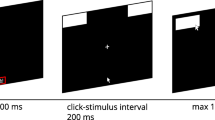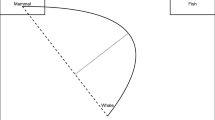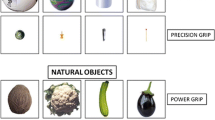Abstract
Human–Computer Interactions pose special demands on the motor system, especially regarding the virtual tool transformations underlying typical mouse movements. We investigated whether such virtual tool-transformed movements are similarly resistant to irrelevant variation of a target object as skilled natural movements are. Results show that such irrelevant information deteriorates performance in perceptual tasks, whereas movement parameters remain unaffected, suggesting that the control of virtual tools draws on the same mechanisms as natural actions do. The results are discussed in terms of their practical utility and recent findings investigating unskilled and transformed movements in the framework of the action/perception model and the integration of tools into the body schema.




Similar content being viewed by others
Notes
We preferred ANOVA over paired-samples t-tests to provide better comparability of the resulting effects sizes with subsequent analyses involving multiple factors.
The final y-coordinate was tightly restricted by the target zone participants were to click on, and we thus did not analyze this dependent measure.
We also computed means of x final and there were significant effects on this variable in Experiments 1b and 2. The corresponding inferential statistics can be found in Table 2; these effects, however, are trivial, since the box coordinates varied on the x-axis in these experiments.
References
Aglioti S, DeSouza JFX, Goodale MA (1995) Size-contrast illusions deceive the eye but not the hand. Curr Biol 5:679–685
Bodner RC, MacKenzie IS (1997) Using animated icons to present complex tasks. In: Proceedings of CASCON ‘97. IBM Canada Ltd, Toronto, pp 281–291
Botvinick M, Cohen J (1998) Rubber hands ‘feel’ touch that eyes see. Nature 391:756
Evans DS (2009) The online advertising industry: economics, evolution, and privacy. J Econ Perspect 23:37–60
Farnè A, Làdavas E (2000) Dynamic size-change of hand peripersonal space following tool use. NeuroReport 11:1645–1649
Franz VH, Gegenfurtner KR (2008) Grasping visual illusions: consistent data and no dissociation. Cogn Neuropsychol 25:920–950
Freeman JB, Ambady N (2011) When two become one: temporally dynamic integration of the face and voice. J Exp Soc Psychol 47:259–263
Freeman JB, Ambady N, Rule NO, Johnson KL (2008) Will a category cue attract you? Motor output reveals dynamic competition across person construal. J Exp Psychol Gen 137:673–690
Freeman JB, Dale R, Farmer TA (2011) Hand in motion reveals mind in motion. Front Psychol 2:59. doi:10.3398/fpsyg.2011.00059
Ganel T, Goodale MA (2003) Visual control of action but not perception requires analytical processing of object shape. Nature 426:664–667
Garner WR (1974) The processing of information and structure. Erlbaum, Potomac
Garner WR (1978) Selective attention to attributes and to stimuli. J Exp Psychol Gen 137:287–308
Gonzalez CLR, Ganel T, Goodale MA (2006) Hemispheric specialization for the visual control of action is independent of handedness. J Neurophysiol 95:3496–3501
Gonzalez CLR, Ganel T, Whitwell RL, Morrissey B, Goodale MA (2008) Practice makes perfect, but only with the right hand: sensitivity to perceptual illusions with awkward grasps decreases with practice in the right but not the left hand. Neuropsychologia 46:624–631
Goodale MA (2008) Action without perception in human vision. Cogn Neuropsychol 25:891–919
Goodale MA, Milner AD (1992) Separate visual pathways for perception and action. Trends Neurosci 15:20–25
Hesse C, de Grave DDJ, Franz VH, Brenner E, Smeets JBJ (2008) Planning movements well in advance. Cogn Neuropsychol 25:985–995
Iriki A, Tanaka M, Iwamura Y (1996) Coding of modified body schema during tool use by macaque postcentral neurones. NeuroReport 7:2325–2330
Iriki A, Tanaka M, Obayash S, Iwamura Y (2001) Self-images in the video monitor coded by Monkeys intraparietal neurons. Neurosci Res 40:163–173
Janczyk M, Kunde W (2010) Does dorsal processing require central capacity? More evidence from the PRP paradigm. Exp Brain Res 203:89–100
Janczyk M, Kunde W (2012) Visual processing for action resists similarity of relevant and irrelevant object features. Psychon B Rev 19:412–417
Janczyk M, Franz VH, Kunde W (2010) Grasping for parsimony: do some motor actions escape dorsal processing? Neuropsychologia 48:3405–3415
Kunde W, Landgraf F, Paelecke M, Kiesel A (2007) Dorsal and ventral processing under dual-task conditions. Psychol Sci 18:100–104
McDougall SJP, De Bruihn O, Curry MB (2000) Exploring the effects of icon characteristics on user performance: the role of item concreteness, complexity, and distinctiveness. J Exp Psychol-Appl 6:291–306
Pfister R, Janczyk M (2013) Confidence intervals for two sample means: calculation, interpretation, and a few simple rules. Adv Cog Psych 9:74–80
Slater M, Perez-Marcos D, Ehrsson HH, Sanchez-Vives MV (2008) Toward a digital body: the virtual arm illusion. Front Human Neurosci 2:6
Slater M, Spanlang B, Sanchez-Vives MV, Blanke O (2010) First person experience of body transfer in virtual reality. PLoS ONE 5:e10565
Song J-H, Nakayama K (2009) Hidden cognitive states revealed in choice reaching tasks. Trends Cogn Sci 13:360–366
Taylor K (2007) An analysis of computer use across 95 organisations in Europe, North America and Australasia. Wellnomics White paper http://wellnomics.com/assets/Uploads/White-Papers/Wellnomics-white-paper-Comparison-of-Computer-Use-across-different-Countries.pdf. Accessed 12 April 2013
Vilchez JL, Tornay F (2012) Irrelevant stimuli produce a path deviation in a driving-simulation task. Cogn Syst Res 17–18:81–89
Witt JK, Proffitt DR, Epstein W (2005) Tool use affects perceived distance but only when you intend to use it. J Exp Psychol Human 31:880–888
Yuan Y, Steed A (2010) Is the rubber hand illusion induced by immersive virtual reality? Proc IEEE Virtual Reality Conf 2010:95–102
Zhang P, von Dran GM (2000) Satisfiers and dissatisfiers: a two factor model for website design and evaluation. J Am Soc Inform Sci 51:1253–1268
Author information
Authors and Affiliations
Corresponding author
Rights and permissions
About this article
Cite this article
Janczyk, M., Pfister, R. & Kunde, W. Mice move smoothly: irrelevant object variation affects perception, but not computer mouse actions. Exp Brain Res 231, 97–106 (2013). https://doi.org/10.1007/s00221-013-3671-5
Received:
Accepted:
Published:
Issue Date:
DOI: https://doi.org/10.1007/s00221-013-3671-5




